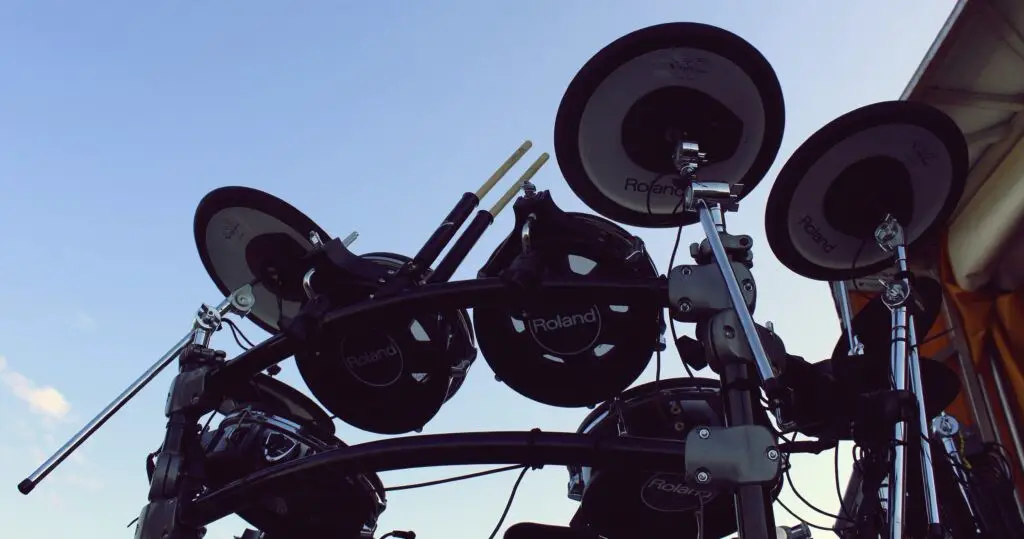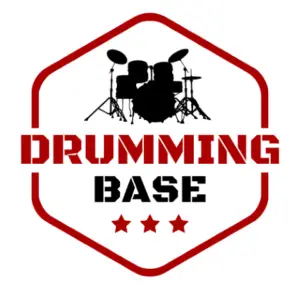Electronic drums are great for home-use because they have a low ambient volume so your neighbours and housemates won’t hear them as much compared to acoustic drums and cymbals. However, you as the drummer, will still want to hear them in their full glory so they sound like an acoustic set. So how do you do it?
Do Electronic Drums Need an Amp?
Electronic drums need an amplifier otherwise only the ambient sound of the pads will be heard, as E-drums typically do not have any internal speakers. To hear the E-drums properly, they must either by plugged into an amp with a built-in speaker, or headphones.
The best way to amplify electronic drums for home practice is to use a dedicated drum amp. For live performances where a higher volume is needed, a PA system can be used to amplify the E-drums. Alternatively, headphones can be used if only the drummer needs to hear the electronic drums.

Best Methods to Amplify Electronic Drums
- Drum amp
- PA system
- Keyboard amp
- Headphones
The best ways to amplify electronic drums are to use either a dedicated drum amp, or a PA system. Drum amps are cheaper, however a PA system will allow you to amplify any instrument to very high volumes whilst still maintaining good audio quality.
Let’s look at each method individually.
Drum Amplifier
The most common way to amplify electronic drums is to use a drum amp (aka a drum monitor). This method isn’t too expensive, and works for a variety of settings. You can get very high power drum amps for live performances, or smaller ones for bedroom practice. They typically cost between $150 and $500.
Drum amps are capable of handling a wide range of frequencies which is imperative as the kick drum for example produces a sound with a very low frequency, whereas the cymbals produce very high frequencies.
Here’s how they work:
- The drum amp and E-drums are connected typically using a 1/4″ or XLR cable
- Each drum pad/ cymbal is connected to a trigger sensor on the drum module
- The pre-amp section of the drum amp strengthens the signal from “instrument level” to “line level”
- The power-amp section of the amp boosts the “line level” signal to “speaker level signal”
- The sound is then played through the built-in speaker
As well as having a speaker, many drum amps also have an AUX input/ output so you can hear your music and play along, and use headphones.

Drum amps also feature various different controls to allow you to adjust the sound of your E-drums. The most common controls are bass, mids and treble, but some amps also come with some effects as well.
If you’re looking for a good quality drum amp that isn’t going to break the bank, check out the Roland PM-100 Drum Monitor on Amazon. It has an angled design to get the optimal sound for the seated drummer, as well as onboard mixing and 80W of power which is good for at-home practice.
Images links to Amazon
PA System
PA systems are the gold standard when it comes to amplifying a wide range of instruments. Like drum amps, PA speakers can handle a wide range of frequencies, that’s why they’re suitable for drums, guitars, keyboards and vocalists.
I wouldn’t recommend a PA system unless you’re planning on gigging, as otherwise they’re just unnecessarily large and expensive. However, if you do want to perform live, a PA system is definitely the way to go.
PA systems consists of several main components:
- Main speakers: these create the bulk of the PA’s sound
- Subwoofers: these produce lower frequencies compared to the main speakers
- Stage monitors: these are positioned near the performer to help them hear themselves
- Amplifier: this raises the instrument level signal to speaker level
- Mixer: this allows you to combine sounds from multiple sources
Many PA systems will also come with EQ controls and effects to help you tweak the sound.
Keyboard Amplifier
Although I would say that using a dedicated drum amp/ PA system is a better option, it is possible to use a keyboard amplifier for electronic drums.
Keyboard amps are also capable of handling a wide range of frequencies so will sound much better than guitar or bass amps (and are also far less likely to get damaged).
If you don’t currently have any solution to amplify your drums, don’t go out and buy a keyboard amp specially. Instead, get yourself a drum amp as it’ll sound better. However, if you have a keyboard amp to hand then you can use it as a good alternative and save yourself some money.
Headphones
Electronic drums will (almost always) have an AUX line output for headphones. This allows you to hear the E-drums properly, but without amplifying the sound of them to your neighbours or housemates. For at-home practice on my own, using headphones is my preferred option.
Make sure you plug your headphones into the AUX output, instead of the input which is designed for you to use to play backing tracks from another device such as a smartphone or laptop. If you can’t hear anything through your headphones, the chances are you’ve plugged them into the MP3 input instead!
As long as you have a decent set of E-drums and some good quality headphones, then you’ll be able to get a great sound out of your kit.
On some electronic drum sets, you’ll be able to pair your headphones wirelessly using Bluetooth or you can use a Bluetooth transmitter on any kit. However, the quality usually isn’t as good as using wired headphones and the latency will be higher (meaning it’ll take longer for you to hear the drums after hitting them).

What NOT to Use
Okay so now we’ve been through 4 of the best methods to amplify your drums, let’s take a look at some methods which I don’t recommend. These include:
- Guitar amps
- Bass guitar amps
- Hi-Fi speakers
Let’s dive into why these aren’t good options.
Guitar and Bass Amps
There are two reasons why I don’t recommend using a guitar or bass guitar amp with an electronic drum kit:
- There is an increased risk of damaging the amp
- The sound quality will be poor
This is because these types of amps are designed to handle specific frequencies ranges produced by the instrument.
- Bass guitars have a fundamental frequency of 60-1000 Hz
- Electric guitars have a fundamental frequency of 80-1200 Hz
- Drums have a fundamental frequency of 30-18,000 Hz
As you can see, drums have a much wider frequency range, thanks to the difference between the bass drum and the cymbals. Guitar and bass amps are not capable of handling these frequencies and at best, will make the drums sound terrible and at worst, blow the speaker.
Check out this article explaining why you shouldn’t use a guitar amp for E-drums to learn more.
Hi-Fi Speakers
Hi-Fi or any other regular household speakers should not be used to amplify drums. As a rough guide, if a speaker is designed to amplify recorded music (instead of live), it’s not suitable to use for E-drums.
The output from an instrument such as E-drums is not high enough without amplification to be able to be heard through the speakers. In order to compensate for this, many people will try turning the volume up more to push more current into the speakers, however this will damage them.
Instead, you need to use PA speakers.


